当前位置:网站首页>Tailq of linked list
Tailq of linked list
2022-07-05 08:06:00 【Car chezi】
List of articles
TAILQ Introduce

TAILQ The queue is FreeBSD A queue data structure in the kernel , In some famous open source libraries ( Such as DPDK、libevent) It has a wide range of applications .
TAILQ and Linux in list They are organized differently , The latter is simply to struct list_head As the hanging point of the linked list , No user information , Their differences are shown in the following figure .
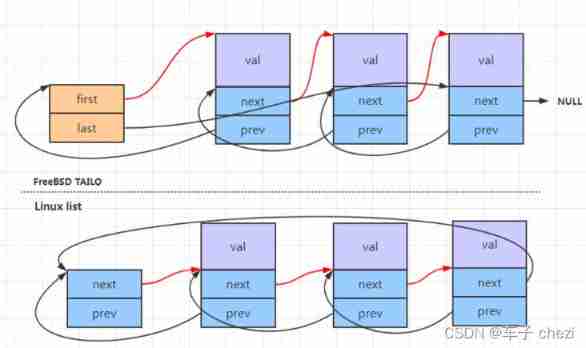
Linux Medium list Only will struct list_head As the hook point of user elements , Therefore, when traversing the linked list in the forward direction , Need to use container_of This kind of interface can obtain user data , and TAILQ because tqe_next The pointer points directly to the user element , So theoretically , Positive traversal TAILQ Than list faster .
The header file
The header file is from the project I recently saw :apache-mynewt-core-1.9.0\sys\sys\include\sys\queue.h
Only part of .
// "bsd_queue.h" In order to test , I have a new name
/* * @(#)queue.h 8.5 (Berkeley) 8/20/94 * $FreeBSD: src/sys/sys/queue.h,v 1.32.2.7 2002/04/17 14:21:02 des Exp $ */
/* * Tail queue declarations. */
#define TAILQ_HEAD(name, type) \ struct name {
\ struct type *tqh_first; /* first element */ \ struct type **tqh_last; /* addr of last next element */ \ }
#define TAILQ_HEAD_INITIALIZER(head) \ {
NULL, &(head).tqh_first }
#define TAILQ_ENTRY(type) \ struct {
\ struct type *tqe_next; /* next element */ \ struct type **tqe_prev; /* address of previous next element */ \ }
/* * Tail queue functions. */
#define TAILQ_EMPTY(head) ((head)->tqh_first == NULL)
#define TAILQ_FIRST(head) ((head)->tqh_first)
#define TAILQ_FOREACH(var, head, field) \ for ((var) = TAILQ_FIRST((head)); \ (var); \ (var) = TAILQ_NEXT((var), field))
#define TAILQ_FOREACH_REVERSE(var, head, headname, field) \ for ((var) = TAILQ_LAST((head), headname); \ (var); \ (var) = TAILQ_PREV((var), headname, field))
#define TAILQ_INIT(head) do {
\ TAILQ_FIRST((head)) = NULL; \ (head)->tqh_last = &TAILQ_FIRST((head)); \ } while (0)
#define TAILQ_INSERT_AFTER(head, listelm, elm, field) do {
\ if ((TAILQ_NEXT((elm), field) = TAILQ_NEXT((listelm), field)) != NULL)\ TAILQ_NEXT((elm), field)->field.tqe_prev = \ &TAILQ_NEXT((elm), field); \ else \ (head)->tqh_last = &TAILQ_NEXT((elm), field); \ TAILQ_NEXT((listelm), field) = (elm); \ (elm)->field.tqe_prev = &TAILQ_NEXT((listelm), field); \ } while (0)
#define TAILQ_INSERT_BEFORE(listelm, elm, field) do {
\ (elm)->field.tqe_prev = (listelm)->field.tqe_prev; \ TAILQ_NEXT((elm), field) = (listelm); \ *(listelm)->field.tqe_prev = (elm); \ (listelm)->field.tqe_prev = &TAILQ_NEXT((elm), field); \ } while (0)
#define TAILQ_INSERT_HEAD(head, elm, field) do {
\ if ((TAILQ_NEXT((elm), field) = TAILQ_FIRST((head))) != NULL) \ TAILQ_FIRST((head))->field.tqe_prev = \ &TAILQ_NEXT((elm), field); \ else \ (head)->tqh_last = &TAILQ_NEXT((elm), field); \ TAILQ_FIRST((head)) = (elm); \ (elm)->field.tqe_prev = &TAILQ_FIRST((head)); \ } while (0)
#define TAILQ_INSERT_TAIL(head, elm, field) do {
\ TAILQ_NEXT((elm), field) = NULL; \ (elm)->field.tqe_prev = (head)->tqh_last; \ *(head)->tqh_last = (elm); \ (head)->tqh_last = &TAILQ_NEXT((elm), field); \ } while (0)
#define TAILQ_LAST(head, headname) \ (*(((struct headname *)((head)->tqh_last))->tqh_last))
#define TAILQ_NEXT(elm, field) ((elm)->field.tqe_next)
#define TAILQ_PREV(elm, headname, field) \ (*(((struct headname *)((elm)->field.tqe_prev))->tqh_last))
#define TAILQ_REMOVE(head, elm, field) do {
\ if ((TAILQ_NEXT((elm), field)) != NULL) \ TAILQ_NEXT((elm), field)->field.tqe_prev = \ (elm)->field.tqe_prev; \ else \ (head)->tqh_last = (elm)->field.tqe_prev; \ *(elm)->field.tqe_prev = TAILQ_NEXT((elm), field); \ } while (0)
give an example
come from https://manpages.courier-mta.org/htmlman3/tailq.3.html
#include <stddef.h>
#include <stdio.h>
#include <stdlib.h>
#include "bsd_queue.h" // of no avail Linux Of , It's my own
struct entry {
int data;
TAILQ_ENTRY(entry) entries; /* Tail queue */
};
TAILQ_HEAD(tailhead, entry);
int
main(void)
{
struct entry *n1, *n2, *n3, *np;
struct tailhead head; /* Tail queue head */
int i;
TAILQ_INIT(&head); /* Initialize the queue */
n1 = malloc(sizeof(struct entry)); /* Insert at the head */
TAILQ_INSERT_HEAD(&head, n1, entries);
n1 = malloc(sizeof(struct entry)); /* Insert at the tail */
TAILQ_INSERT_TAIL(&head, n1, entries);
n2 = malloc(sizeof(struct entry)); /* Insert after */
TAILQ_INSERT_AFTER(&head, n1, n2, entries);
n3 = malloc(sizeof(struct entry)); /* Insert before */
TAILQ_INSERT_BEFORE(n2, n3, entries);
TAILQ_REMOVE(&head, n2, entries); /* Deletion */
free(n2);
/* Forward traversal */
i = 0;
TAILQ_FOREACH(np, &head, entries)
np->data = i++;
/* Reverse traversal */
TAILQ_FOREACH_REVERSE(np, &head, tailhead, entries)
printf("%i\n", np->data);
/* TailQ deletion */
n1 = TAILQ_FIRST(&head);
while (n1 != NULL) {
n2 = TAILQ_NEXT(n1, entries);
free(n1);
n1 = n2;
}
TAILQ_INIT(&head);
exit(EXIT_SUCCESS);
}
The code analysis
TAILQ_ENTRY and TAILQ_HEAD
struct entry {
int data;
TAILQ_ENTRY(entry) entries; /* Tail queue */
};
TAILQ_HEAD(tailhead, entry);
TAILQ_ENTRY(entry) entries Medium entry Specified by the user , It is the label of the outer large structure , After the macro is expanded, the following page 1,4,5 In a row entry;entries Also specified by the user , Is the member name of the unlabeled structure , After the macro is expanded, the following page 6 In a row entries
struct entry {
int data;
struct {
struct entry *tqe_next;
struct entry **tqe_prev;
} entries;
};
struct tailhead {
struct entry *tqh_first;
struct entry **tqh_last;
};
TAILQ_HEAD(tailhead, entry) Medium tailhead Specified by the user , It is the label of the header structure , As in paragraph above 9 Yes tailhead,entry Want to be with TAILQ_ENTRY The first parameter in is consistent .
struct entry **tqh_last and struct entry **tqe_prev It looks a little strange , Why is it a secondary pointer ?
Is it OK to change it to level one ?
If you put the 5 Change line to struct entry *tqe_prev, Definitely not , What if the head node is in front of it , There is no struct entry ah !
Take a closer look , Whether it's a header node or a normal node , There are struct entry * This type , Then define a type as struct entry ** Variable of . In this way, the forward insertion can be handled uniformly , For example, see TAILQ_INSERT_BEFORE
To sum up , Definition TAILQ When , Yes 3 Basic elements :
Structure struct entry:TAILQ_ENTRY() Parameters and TAILQ_HEAD() Second parameter of
Structure struct tailhead:TAILQ_HEAD() The first parameter of
Variable entries: Keep up with the TAILQ_ENTRY() Back
TAILQ_INIT
struct entry *n1, *n2, *n3, *np;
struct tailhead head; /* Tail queue head */
int i;
TAILQ_INIT(&head); /* Initialize the queue */
The first 5 That's ok , Macro expansion yes
(((&head))->tqh_first) = ((void *)0);
(&head)->tqh_last = &(((&head))->tqh_first);
It means header tqh_first by NULL,tqh_last self-directed tqh_first
TAILQ_INSERT_HEAD
n1 = malloc(sizeof(struct entry)); /* Insert at the head */
TAILQ_INSERT_HEAD(&head, n1, entries);
2: Macro expansion
if (((((n1))->entries.tqe_next) = (((&head))->tqh_first)) != ((void *)0))
(((&head))->tqh_first)->entries.tqe_prev = &(((n1))->entries.tqe_next);
else
(&head)->tqh_last = &(((n1))->entries.tqe_next);
(((&head))->tqh_first) = (n1);
(n1)->entries.tqe_prev = &(((&head))->tqh_first);
To put n1 Insert into the first position of the queue , Which pointers need to be modified ?
- n1 Of entries.tqe_next
- n1 Of entries.tqe_prev
- (&head))->tqh_first
- Of the first node before entries.tqe_prev
- If n1 Is the only node , It needs to be revised (&head)->tqh_last
good , Let's see how the code solves .
The first 1 OK, it's solved 1
The first 2 OK, it's solved 4, This needs to be explained ,(((&head))->tqh_first)->entries.tqe_prev Indicates insertion n1 Of the previous first node tqe_prev, After inserting , It should point to n1 Of tqe_next
The first 4 OK, it's solved 5
The first 6 OK, it's solved 3
The first 7 OK, it's solved 2
TAILQ_INSERT_TAIL
n1 = malloc(sizeof(struct entry)); /* Insert at the tail */
TAILQ_INSERT_TAIL(&head, n1, entries);
hold n1 Insert at the end of the queue , Which pointers need to be modified ?
- (&head)->tqh_last
- n1 Of entries.tqe_next Should be NULL
- n1 Of entries.tqe_prev
- n1 The last node before inserting ( It's called n0 Well ) Of entries.tqe_next
The first 2 That's ok , Expand macro
(((n1))->entries.tqe_next) = ((void *)0);
(n1)->entries.tqe_prev = (&head)->tqh_last;
*(&head)->tqh_last = (n1);
(&head)->tqh_last = &(((n1))->entries.tqe_next);
The first 1 OK, it's solved 2
The first 2 OK, it's solved 3
The first 3 OK, it's solved 4, Because before inserting (&head)->tqh_last Point to n0 Of entries.tqe_next, Yes (&head)->tqh_last Quoting , You get the variable n0 Of entries.tqe_next, It should be equal to n1
The first 4 OK, it's solved 1
TAILQ_INSERT_AFTER
n2 = malloc(sizeof(struct entry)); /* Insert after */
TAILQ_INSERT_AFTER(&head, n1, n2, entries);
hold n2 Insert into n1 Behind , Which pointers need to be modified ?
- n1 Of entries.tqe_next
- n2 Of entries.tqe_prev
- n2 Of entries.tqe_next
- Insert n2 Before , If n1 Behind a n3, It needs to be modified n3 Of entries.tqe_prev;
- Insert n2 Before , If n1 It's the last node , Then modify (&head)->tqh_last
The first 2 Line macro expansion :
if (((((n2))->entries.tqe_next) = (((n1))->entries.tqe_next)) != ((void *)0))
(((n2))->entries.tqe_next)->entries.tqe_prev = &(((n2))->entries.tqe_next);
else
(&head)->tqh_last = &(((n2))->entries.tqe_next);
(((n1))->entries.tqe_next) = (n2);
(n2)->entries.tqe_prev = &(((n1))->entries.tqe_next);
The first 1 OK, it's solved 3
The first 2 OK, it's solved 4
The first 4 OK, it's solved 5
The first 6 OK, it's solved 1
The first 7 OK, it's solved 2
TAILQ_INSERT_BEFORE
n3 = malloc(sizeof(struct entry)); /* Insert before */
TAILQ_INSERT_BEFORE(n2, n3, entries);
hold n3 Insert into n2 In front of , Which pointers need to be modified ?
n3 Of entries.tqe_next
n2 Of entries.tqe_prev
n3 Of entries.tqe_prev
Insert n3 Before , If n2 In front of n1, It needs to be modified n1 Of entries.tqe_next,
namely
(n1)->entries.tqe_next = n3;Insert n3 Before , If n2 It's the first node , Then modify (&head)->tqh_first,
namely
(&head)->tqh_first = n3;
The first 2 Line macro expansion
(n3)->entries.tqe_prev = (n2)->entries.tqe_prev;
(((n3))->entries.tqe_next) = (n2);
*(n2)->entries.tqe_prev = (n3);
(n2)->entries.tqe_prev = &(((n3))->entries.tqe_next);
The first 1 OK, it's solved 3
The first 2 OK, it's solved 1
The first 3 OK, it's solved 4 and 5( I'll explain right away )
The first 4 OK, it's solved 2
explain :
Insert n3 Before , If n2 In front of n1,
that *(n2)->entries.tqe_prev On behalf of the variable (n1)->entries.tqe_next
Insert n3 Before , If n2 It's the first node ,
that *(n2)->entries.tqe_prev On behalf of the variable (&head)->tqh_first
So these two situations can be combined , It's written in
*(n2)->entries.tqe_prev = (n3);
TAILQ_REMOVE
TAILQ_REMOVE(&head, n2, entries); /* Deletion */
free(n2);
To put n2 Remove... From the linked list , Which pointers need to be modified ?
- n2 The front node ( The assumption is n1) Of entries.tqe_next
- n2 The back node ( The assumption is n3) Of entries.tqe_prev
- If n2 It's the last node , Then we need to modify it (&head)->tqh_last
The first 1 Line macro expansion
if (((((n2))->entries.tqe_next)) != ((void *)0))
(((n2))->entries.tqe_next)->entries.tqe_prev = (n2)->entries.tqe_prev;
else
(&head)->tqh_last = (n2)->entries.tqe_prev;
*(n2)->entries.tqe_prev = (((n2))->entries.tqe_next);
The first 1 Line judgment n2 Whether it is the last node
The first 2 OK, it's solved 2
The first 4 OK, it's solved 3
The first 5 OK, it's solved 1, Let's explain .(n2)->entries.tqe_prev Pointing to n1 Of entries.tqe_next, Yes (n2)->entries.tqe_prev Quoting , Get the variable (n1)->entries.tqe_next, It needs to be assigned n3 The address of , namely (n2)->entries.tqe_next; If (n2)->entries.tqe_prev Pointing to the header tqh_first, The first 5 Line is also established
TAILQ_FOREACH
i = 0;/* Forward traversal */
TAILQ_FOREACH(np, &head, entries)
np->data = i++;
The first 2 Line is
for ((np) = (((&head))->tqh_first); (np); (np) = (((np))->entries.tqe_next))
Relatively simple , There is no need to explain .
TAILQ_FOREACH_REVERSE
/* Reverse traversal */
TAILQ_FOREACH_REVERSE(np, &head, tailhead, entries)
printf("%i\n", np->data);
Let's change our mind this time , Don't look at what it is after expansion , Instead, look at the definition of macros
#define TAILQ_FOREACH_REVERSE(var, head, headname, field) \ for ((var) = TAILQ_LAST((head), headname); \ (var); \ (var) = TAILQ_PREV((var), headname, field))
#define TAILQ_LAST(head, headname) \ (*(((struct headname *)((head)->tqh_last))->tqh_last))
#define TAILQ_PREV(elm, headname, field) \ (*(((struct headname *)((elm)->field.tqe_prev))->tqh_last))
The first 7 That's ok , You can get the address of the last node . Explain it. :
(head)->tqh_last Is the last node entries.tqe_next The address of , But this address is not what the user wants , What the user wants is the address of the node , It's a big structure ( struct entry ) The address of , So we have to save the country by curving , Here's the picture , from 1 To 2 Until then 3
from entries.tqe_next How to get the address of entries.tqe_prev The value of ?
It's not hard , although struct entry Inside entries This structural variable has no label , But its element composition and struct headname Exactly the same as , It's all one struct entry * and One struct entry **, So you can put entries.tqe_next Cast address to (struct headname *) type : (struct headname *)((head)->tqh_last)
Then visit its tqh_last member ( That's what this is prev):
((struct headname *)((head)->tqh_last))->tqh_last
In this way, we get the of the previous node entries.tqe_next The address of , Then dereference it :
*(((struct headname *)((head)->tqh_last))->tqh_last)
Got it. entries.tqe_next Variable , This happens to be a large structure ( struct entry ) The address of
We'll see TAILQ_PREV This macro , The reason is similar to .

As shown in the figure , from 1 To 2 Until then 3
Let the address of the current node be elm( The last node is used to illustrate ),(elm)->field.tqe_prev , Indicates following 1, Get the node in front of it next The address of , Force this address to struct headname *, namely
(struct headname *)((elm)->field.tqe_prev)
Revisit prev, That is to follow 2, Got it elm In front of the front node next Address
namely ((struct headname *)((elm)->field.tqe_prev))->tqh_last
Dereference it , You get elm In front of the front node next, namely
*(((struct headname *)((elm)->field.tqe_prev))->tqh_last)
It happens to be 3 This pointer represents the address .
Other macros are simpler , No introduction
Reference material
https://manpages.courier-mta.org/htmlman3/tailq.3.html
TAILQ One or two things in the queue - SegmentFault Think no
边栏推荐
- Fundamentals of C language
- The printer encountered an abnormal configuration problem 0x8007007e (win10)
- . Net service governance flow limiting middleware -fireflysoft RateLimit
- C WinForm [exit application] - practice 3
- 导电滑环磨损快的原因
- Anonymous structure in C language
- Extern keyword function
- L'étude a révélé que le système de service à la clientèle du commerce électronique transfrontalier a ces cinq fonctions!
- Halcon's practice based on shape template matching [2]
- Altium designer 19.1.18 - Import frame
猜你喜欢
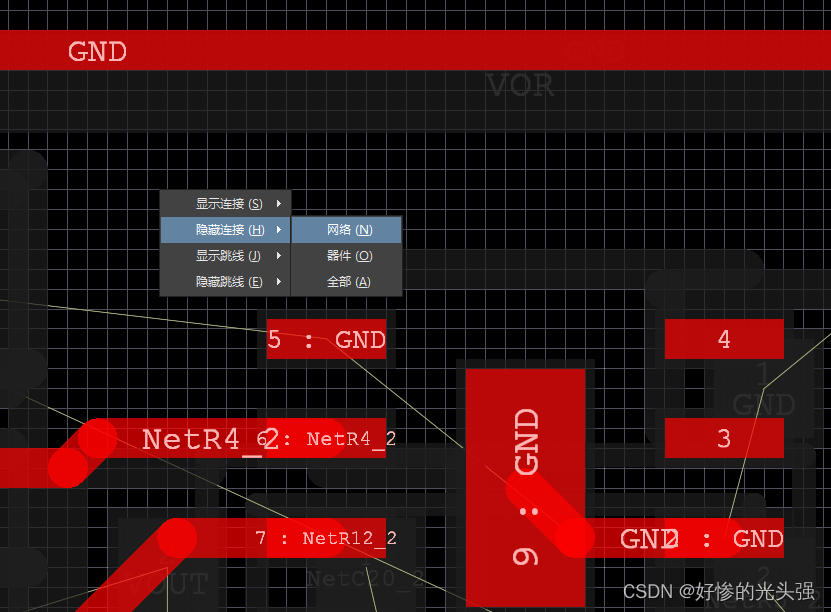
Altium designer 19.1.18 - hide the fly line of a network
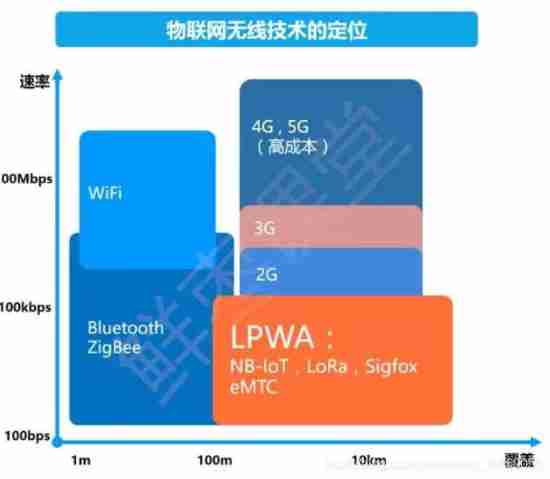
Nb-iot technical summary

Carrier period, electrical speed, carrier period variation
![[tutorial 15 of trio basic from introduction to proficiency] trio free serial communication](/img/08/7f28008a4aa999650998ba8dee5d8e.jpg)
[tutorial 15 of trio basic from introduction to proficiency] trio free serial communication

C language # and #
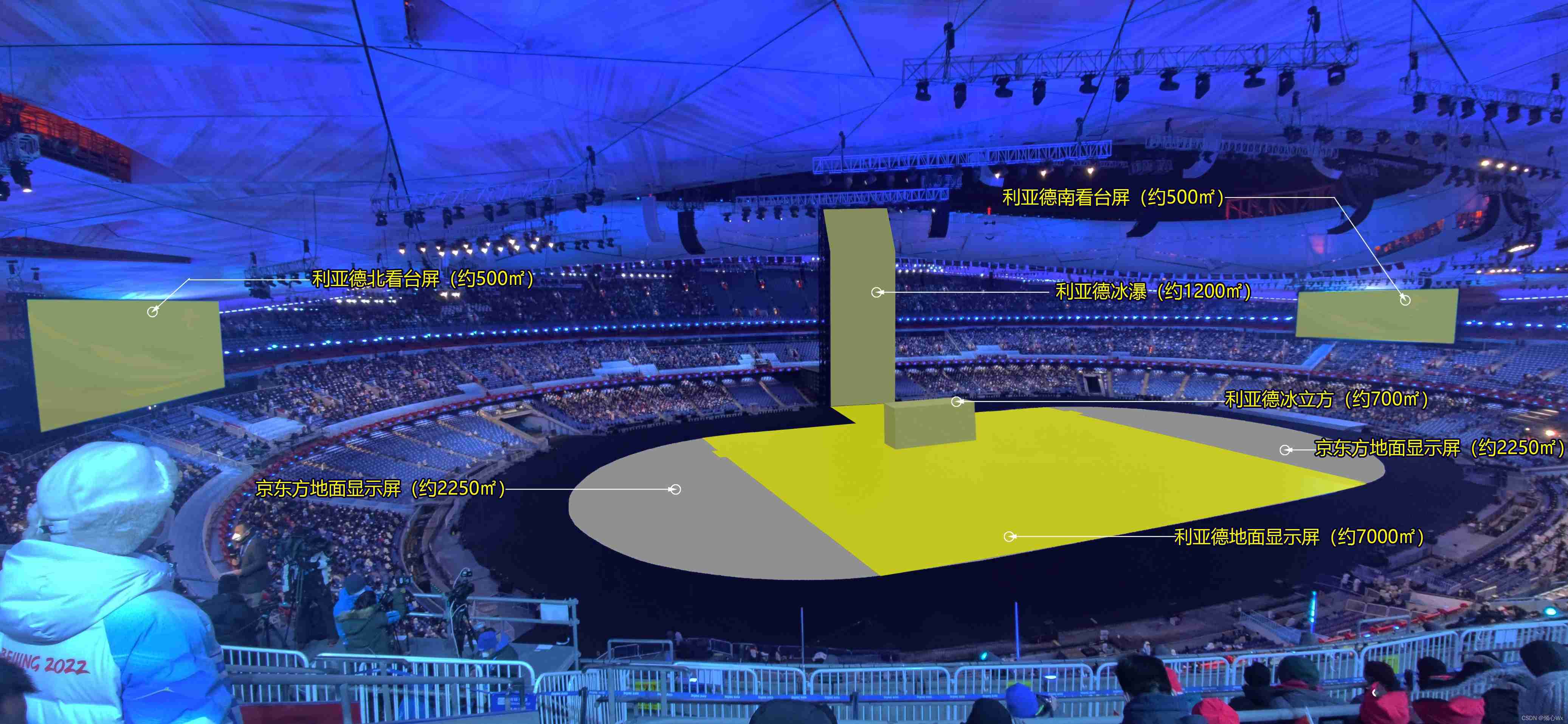
Record the visual shock of the Winter Olympics and the introduction of the screen 2
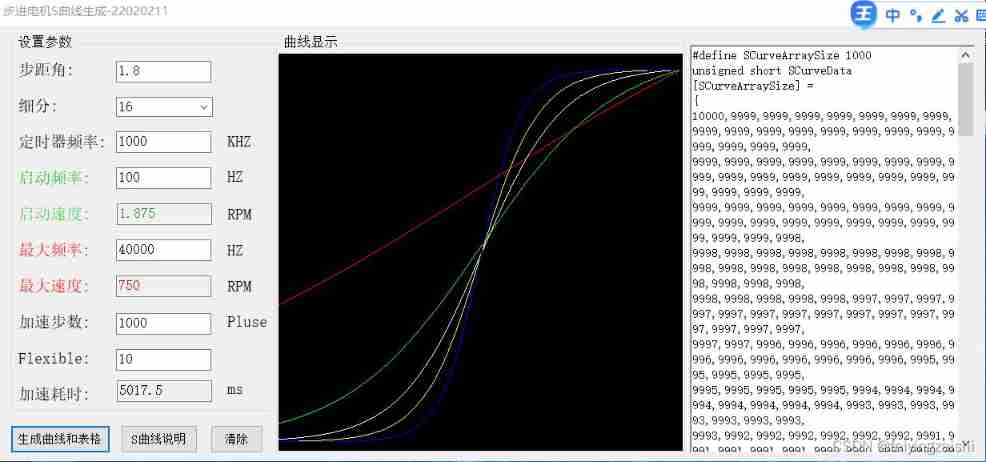
Step motor generates S-curve upper computer
![Correlation based template matching based on Halcon learning [II] find_ ncc_ model_ defocused_ precision. hdev](/img/42/d857452ccfeccbbf1ac34f47e47e2e.jpg)
Correlation based template matching based on Halcon learning [II] find_ ncc_ model_ defocused_ precision. hdev
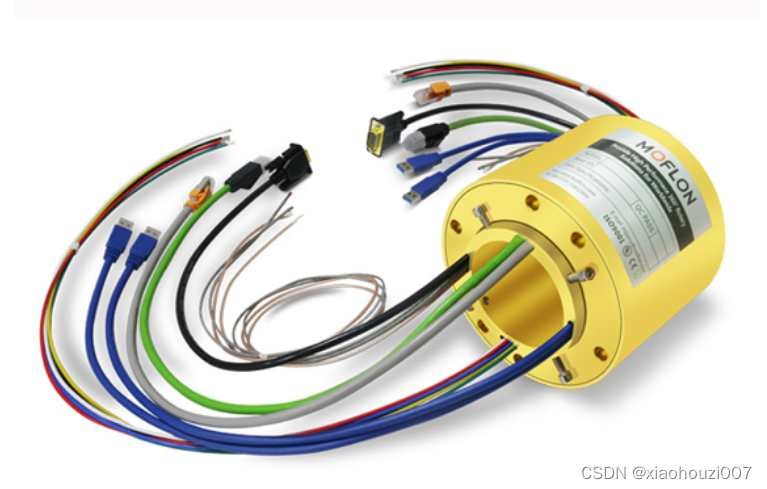
Factors affecting the quality of slip rings in production

Summary -st2.0 Hall angle estimation
随机推荐
如何将EasyCVR平台RTSP接入的设备数据迁移到EasyNVR中?
Shape template matching based on Halcon learning [VII] reuse_ model. Hdev routine
Explication de la procédure stockée pour SQL Server
动力电池UL2580测试项目包括哪些
Basic information commands and functions of kernel development
Markdown tips
Arduino uses nrf24l01+ communication
Altium designer 19.1.18 - Import frame
Gradle复合构建
Define in and define out
How to define guid in AMI code
Shell脚本基本语法
Adaptive filter
Cadence simulation encountered "input.scs": can not open input file change path problem
Sizeof (function name) =?
Win10 shortcut key
Design a clock frequency division circuit that can be switched arbitrarily
Global and Chinese market of core pallets 2022-2028: Research Report on technology, participants, trends, market size and share
Imx6ull bare metal development learning 1-assembly lit LED
Hardware 1 -- relationship between gain and magnification